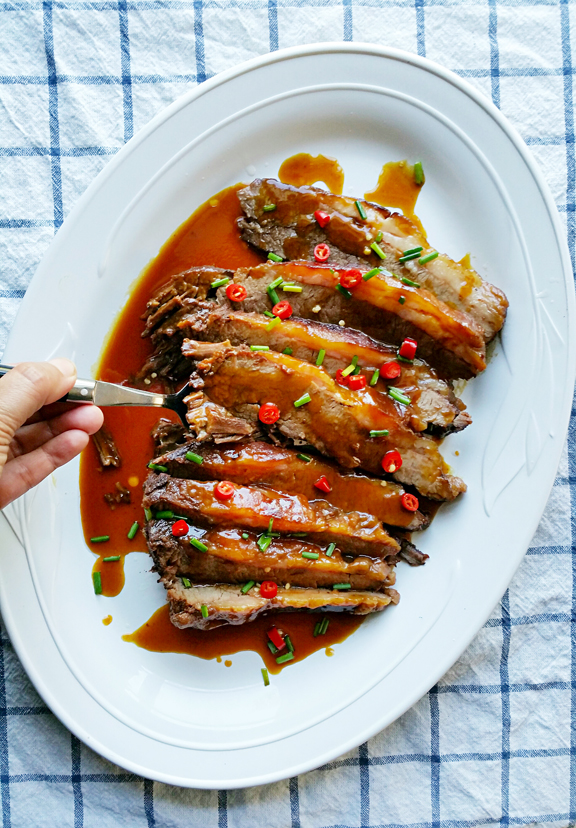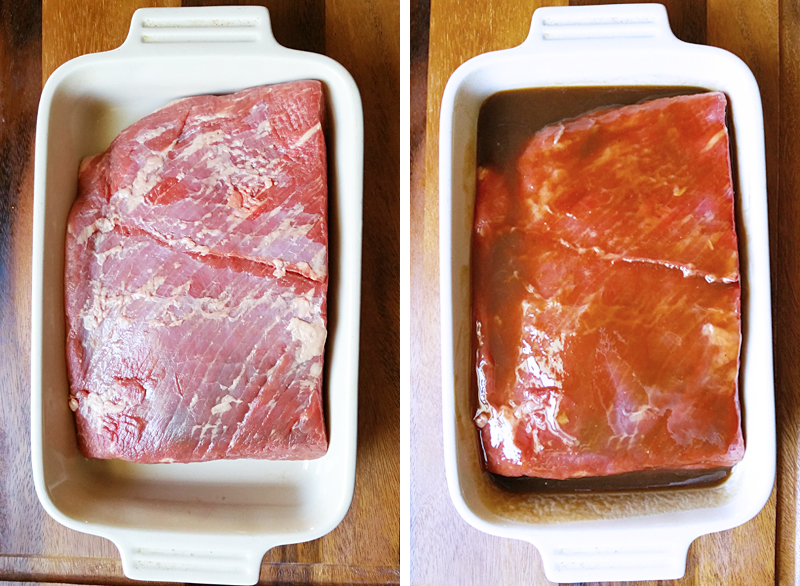
I’m a big, big fan of Jewish-style sweet and sour brisket. In fact, after having tried at least 10 different recipes for it in the past decade, I’ve discovered that even the least impressive batch was delicious to me. It’s almost like you really need to try pretty hard to mess it up.

The world probably doesn’t need another sweet and sour brisket recipe, but I’ll put mine out there anyway, because I just love it. The sweetness comes from Thai palm sugar; tamarind pulp provides the acidity—the fruity, subdued kind of tartness; fish sauce shows up to the party with salinity in one hand and just the right amount of funk in the other. The fresh red bird’s eye chilies that you add just before serving add vibrancy—along with heat—to this slow-cooked dish. If you prefer your brisket without the chilies, add chopped cilantro instead.
Regardless, this dish is meant to be enjoyed with warm jasmine rice. I also like to serve it with a simple stir-fry of broccoli rabe or rapini (follow this recipe, replacing the crown dairy with broccoli rabe and cooking it a little longer) which lends its bitterness to the ensemble. In that one meal, you get sour, sweet, salty, spicy, and bitter—the whole gang is here.
- ½ cup packed grated palm sugar
- ½ cup tamarind pulp (Prepare it yourself or use a Thai brand only. Do not use an Indian brand of tamarind like Tamicon or Swad; they're great for Indian food, but they'll ruin this—or any Thai—recipe. Added September 18th, 2016: The reason Indian-style tamarind won't work is because it's usually cooked down to the consistency of molasses whereas Thai- or Southeast Asian-style tamarind is the pulp which has simply been diluted with water. So even though both types are made from the same material, they're so different from one another that to replace one for another will result in unintended appearance and flavor. When a Thai recipe calls for tamarind pulp, unless otherwise indicated, it never refers to the syrupy tamarind concentrate.)
- 2 tablespoons fish sauce
- 2¼-2½ pounds beef brisket
- 1 tablespoon cornstarch
- As many fresh red bird's eye chilies as you'd like, stemmed and cut crosswise into ¼-inch slices
- 1 tablespoon finely sliced chives or green onions
- Position an oven rack in the middle. Preheat the oven to 300°F.
- Meanwhile, combine the sugar, tamarind, and fish sauce in a small saucepan; set over medium heat and heat, stirring constantly, just until the sugar has melted (no need to bring it to a boil). Take off the heat. Taste to see if you like it (in other words, to see if our tastes align) and adjust seasoning as needed. Aim for sweet and sour with salty trailing behind. Once the sauce tastes good to you, set it aside.
- Place a ceramic baking dish (that is only slightly larger than the brisket—don't use a pan that's too small which will cause the liquid to overflow (the brisket will release more juice) or too large which will cause the liquid to spread out too much and be too shallow to braise the meat) on a baking sheet.
- Spread half of the prepared sauce on the bottom of the baking dish. Place the brisket, fat side down, in the dish and pour the remaining sauce all over the brisket.
- Cover tightly with foil and put the baking sheet (with the baking dish on it) on the prepared rack in the oven.
- Bake undisturbed 4 to 4½ hours just until the brisket is fork tender but still has some bite to it and holds it shape. The cooking time is determined by the dimensions of the brisket and not so much the total weight, so you will have to play it by ear.
- Remove the foil and turn it over so the dry side is down and the side that touches the brisket is up. Shake off the liquid that clings to the brisket back into the dish and transfer the brisket to the foil. Wrap the brisket with the foil and leave to cool to slightly warmer than room temperature.
- Pour the liquid that remains in the dish into a heatproof glass measurement cup. Leave it undisturbed for a few minutes to allow the fat to rise to the top. Skim off the fat. Hopefully, you'll have 1 cup of braising liquid left after the fat has been skimmed off. If not, add more water to the liquid to get 1 cup.
- Place the liquid in a small saucepan. Whisk in the cornstarch, making sure there are no lumps. Put the pan on medium-high heat and bring to a boil, whisking constantly, until the liquid thickens into a silky gravy—a bit on the runny side.
- Slice the brisket against the grain into ½-inch slices. Arrange the meat on a serving platter. Pour the sauce over it. Scatter the sliced chilies and chives on top. Serve with warm jasmine rice and a vegetable dish of your choice.











Comments are closed.